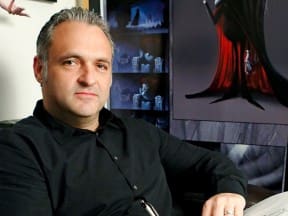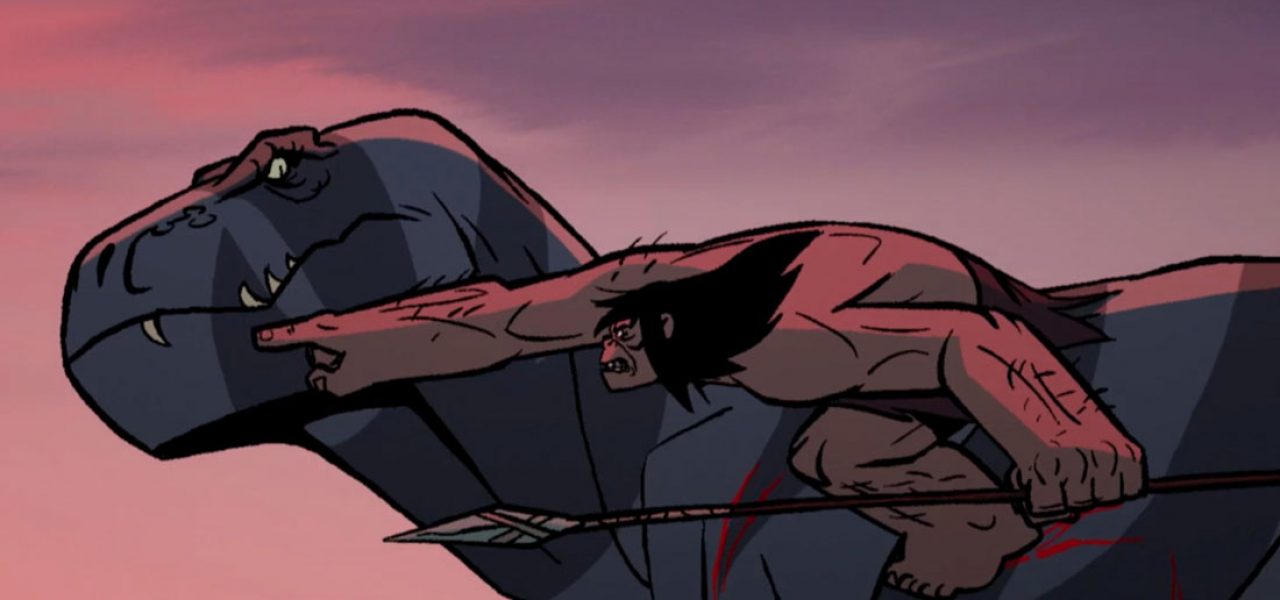
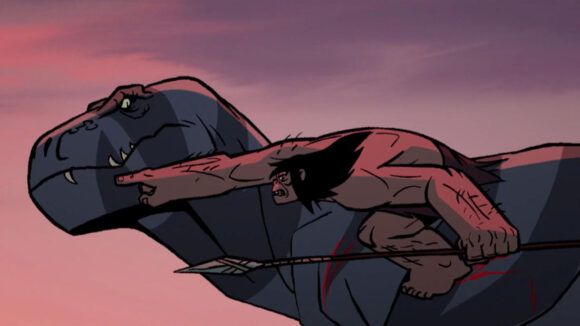
‘Primal’ Creator Genndy Tartakovsky: ‘Animation Is Too Fast. I Wanted To Slow Things Down.’
A caveman and a dinosaur, united by a shared trauma, team up to fend for themselves in a lawless primeval world. In each episode, they encounter other species with interests of their own and, more often than not, a hostile demeanor. Cue fights, chases, and bonding sessions between the odd-couple protagonists.
That is Genndy Tartakovsky’s Primal in a nutshell — but then a nutshell can’t contain the flamboyant action and bold visuals that make this show such a joy to watch. The series tells its tale of friendship and survival without a word of dialogue, staging its set-pieces with a rhythmic energy that befits the title.
In shows like Dexter’s Laboratory and Samurai Jack, Tartakovsky demonstrated his fine sense of timing and flair for expressionistic design. These qualities reach new levels of sophistication in Primal, his first original work of 2d animation since he directed the Hotel Transylvania trilogy at Sony Pictures Animation.
The five-episode series debuted in October on Adult Swim, Cartoon Network’s adult programming block (which also aired Samurai Jack); another five will follow next year. The first five episodes were also packaged into a feature called Genndy Tartakovsky’s Primal — Tales of Savagery, which is currently contending for this year’s Academy Award. This is the version I watched, before calling Tartakovsky to discuss the project.
As a dialogue-free series, Primal is quite unusual. What exactly did you pitch to Adult Swim?
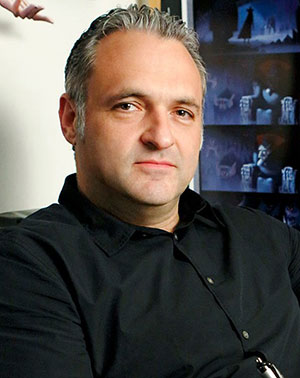
Tartakovsky: The idea is something I’ve had for a while. It actually started off as an idea about a little kid and his dinosaur — a normal kids’ tv show. But after I finished the last season of Samurai Jack [in 2017], which is for Adult Swim and for adults, it got such a positive reaction that I brought that idea back.
The year before I was doing Samurai Jack, I was frustrated, creatively, and I wanted to try something different. So I was working on this short, never intending it to be a series or movie or anything. I had it ready, and Jack was so successful that I pitched it to Mike Lazzo, my boss [at Adult Swim]. He was like, “This is great.” I pitched it very simply, but there’s a lot more to it than just the pitch. It’s a difficult project to pitch without any visuals.
So the short film already had no dialogue?
That’s right. Through most of my career, the things people react to the most are the really visceral sequences — the ones with just sound effects or music. And I thought, “Could we make a whole show or movie with just those sequences put together?”
Are you often guided in your choice of projects by the public’s reaction to your previous work?
No, not usually. It’s a new thing, because when I was making Dexter, Star Wars: Clone Wars, even Samurai Jack, it was pre-internet, so we never had that kind of feedback. I’d have to wait to go to a comic book convention or some kind of speaking engagement. Besides ratings, those would be my reactions. Now, with internet, you kind of get instant feedback. For Jack, it was internet reactions and an overwhelming number of people contacting me.
Each episode in Primal is built around a confrontation between the main characters and a different species. When developing the narrative, did you start by designing each species?
We usually [started with] a tonal idea, or a mood. It wasn’t necessarily a “creature of the week,” a Godzilla-type thing. It was more about what I wanted to feel here, and really how I wanted to progress [the two protagonists’] relationship.
And the creature designs followed?
Yeah. Usually, doing the story meetings, I’ll [have] an initial spark. After doing things for so long, you trust your instincts. The very first thing that snaps into my head, usually, I’m pretty close to the final picture. Especially for television. We’ve always tried to think of everything visually, even for the shows that we had dialogue for.
So these instincts are something you’ve honed throughout your career?
Definitely. When you’re young and starting out, you have no clue what’s right or wrong! And as I started doing Dexter, especially… Dexter came about because I wanted to try things my way. Before that, all my storyboarding was getting changed. I just wanted to try something the way I saw it, for success or failure — I didn’t care at the time. I just wanted to see if these ideas were good. Luckily, it did work.
When I look at something, whether it be design or story, my gut usually… You have a twinkle, almost like a butterfly, like, “Oh my god, this is going to be amazing.” Or, “Something about this isn’t right.” So then we have to dive in and see where it’s going.
Coming back to the two protagonists of Primal: what were your references for the way they move?
For the caveman, who we call Spear, it was really trying to make it feel like he’d just evolved into man, but when he gets angry he becomes more ape-like. He’ll start to run on all fours… Because there’s no dialogue, there’s no gesturing. It was really more about, “How do I pose him?” The eyes, all his expressions, were very important. With everything I’ve done, there’s always a level of cartooniness, because I feel like that allows us to be more expressive, more unique to each expression, and there’s more subtlety.
For Fang the dinosaur, it was a big challenge, because I’d never done a creature like that as a main character. So the whole library of poses and angles on her face [were difficult]. We didn’t want to make it cartoony as far as her expressions — we wanted to keep her more of a beast.
I looked at most dinosaur movies, drawings on the internet. A lot of illustrations, like the Douglas Henderson stuff, some William Stout. Just to see the way they drew the poses of the dinosaurs. And then we went from there and started to develop our own language. It was definitely a lot more challenging than I’d expected.
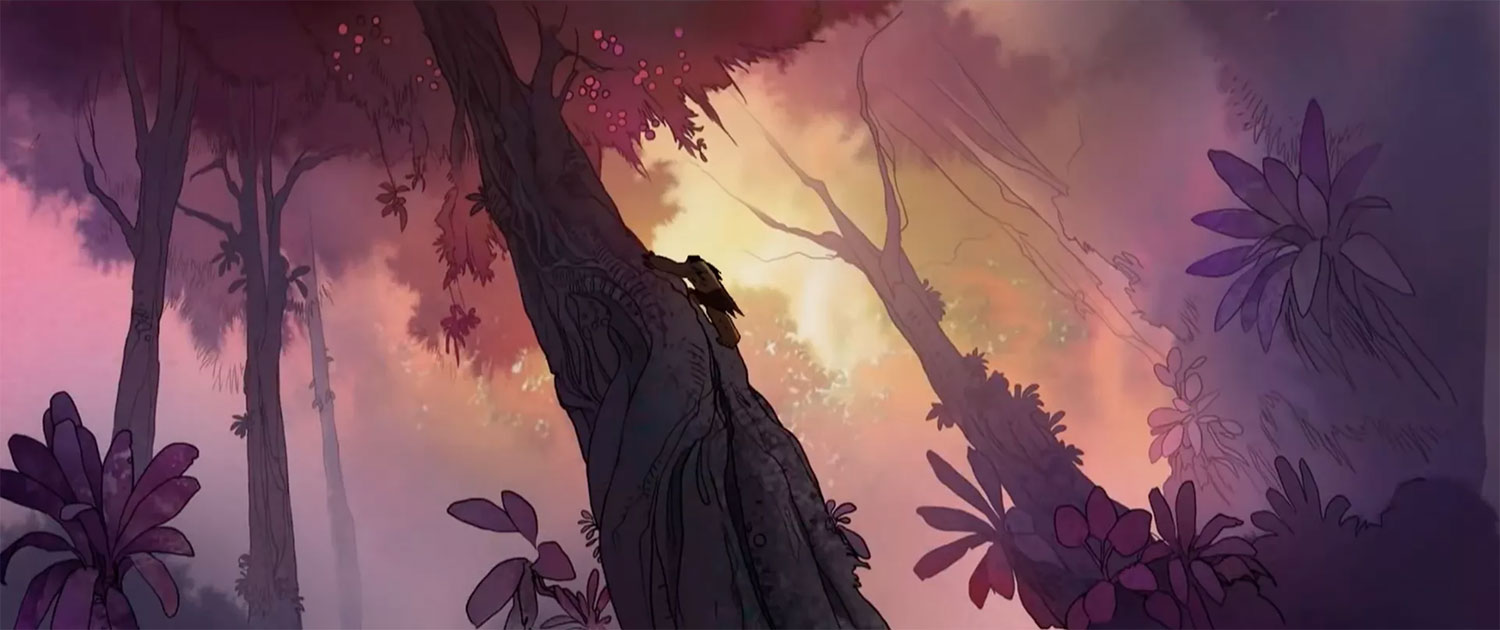
I’m not talking here about the movements, which are stylized, so much as the staging and pacing of some of the action sequences: they reminded me of nature shows like the BBC’s.
Totally. For the third chapter with the woolly mammoth, the biggest inspiration was all those documentaries where you watch this amazing polar bear. You love the bear and you want him to survive, but for that, he has to eat a little baby seal! Of course, you don’t want anybody to die, because you love both the characters. I was the most excited about that, because it’s such unique storytelling. It’s such a dramatic situation, [where] there is no bad guy, so to speak.
The sense of timing throughout Primal is sublime. You’ve done a lot of action shows, but also comedy. Are comic timing and action timing essentially the same skill?
It’s a good question. It’s difficult. Comedy, I would say, is much harder, because it’s very subjective. I really don’t know what you think is funny, what a kid thinks is funny, etc. You try to follow your gut, again, and if you can make the people you’re working with laugh, then it kind of works.
With an action sequence, I just think about music and rhythm. With any good piece of music, there’s highs and lows, fast and slow. I really try to think of it that way: “fight, fight, fight… slow… fight, fight, fight.” Everything I’ve done in the past, I always felt like I was rushing. On Dexter, it was all about things having to be quick and tight.
As we progressed into Jack, we were like, “I’m going to slow things down a little bit.” I really wanted to get the audience to feel. Instead of just a pan of a background, I wanted you to get sucked in and really look at the environment. That’s hard when it’s just an illustration. With Primal, I’m like, “I’m going to slow it down even more.” Because I always feel like I’m not giving enough room for the music or the sound effects.
There’s no way I could have done something like this when I started. I just would not have had the patience — I’d have worried that the audience was going to disconnect.
You’ve said, “Nobody is doing storytelling like [Primal] where you can really take time to breathe.” Do you stand by that?
Of course, there’s live-action movies that do that, like The Revenant. Live action takes its time, because you have the actor’s face, and there’s so much subtlety there. Even going back to the old Sergio Leone movies: you could be 15 seconds on Clint Eastwood’s face, and you’re riveted.
But in animation, it’s all about cut, cut, cut — you have to keep things moving. I wanted to go against that grain, and trust the music, drawings, and story to let people in. I don’t think there’s much out there that takes its time like that, especially contemporary-wise.

Can you describe your working relationship with your composers and sound designer on Primal?
The music is written after all the picture is done, and cut to length. We’ll sit together, and go through the episode sequence by sequence, and talk about pacing, mood… We wanted the music to be a little different: not purely classical, not completely electronic. I really heard this very raw, simplistic sound, but still very emotional, and everything always related back to the title of the show.
We really just wanted it to be simple. Simplicity has its own complexity. That kind of sounds bullshitty! But I kind of described it like that, and they had to figure out how to do it. Tyler [Bates] and Joanne [Higginbottom, the composers] are great — I’ve worked with Tyler on the last season of Samurai Jack and Sym-Bionic Titan. It was great for them, because there’s no dialogue, and the sequences are longer and properly paced for the emotion, [so] they had room.
I’ve been working with Joel [Valentine, the sound designer] since even before Dexter. He’s done everything I’ve done besides Clone Wars. There’s a like-mindedness when you find people you connect with. If I say, “Pow!”, he knows exactly what I’m talking about. The challenge was to develop a voice for Fang. I didn’t want just the normal roars. She really developed her own sound, with the little clicks and moans, which brought her to life.
I saw the theatrical version of Primal. Inevitably, its pacing is different to that of any one episode. What do you think of this version? Does it turn the series into a new kind of work?
For sure, it’s a different experience. One surprising thing that came out of [the theatrical version]: it’s like I felt the character relationship even more, because you see the arc of their meeting, their working together, their surviving together. This is a bit what we were doing in the show too — that was the point — but it did feel heightened in the theatrical version.
And just sitting in the big screen and watching it with an audience is, in its own way, a unique experience. I’ve sat in multiple screenings, and it’s a hard thing to sit through, because it’s quite intense, and the audience is very quiet. I was thinking, “Oh no, everybody’s sleeping!” But they’re sucked in, and it’s great.
Is this linked to the lack of dialogue?
Yeah. This is something I wasn’t anticipating, also. A lot of times, when a cartoon starts, or even live action, your brain almost shuts off, because you can understand everything from the dialogue. But with this, if you turn away, you’re going to miss a bunch.
Your relationship with Cartoon Network and Adult Swim stretches back decades. What makes that relationship work?
Mutual trust is the biggest one. Mike Lazzo, the one who approves everything creatively for me, was in the room when they greenlit Dexter’s Lab. He gives you notes or whatever, but you can tell they’re coming from a real place. There’s no politics. Sometimes I agree with the note, sometimes I don’t.
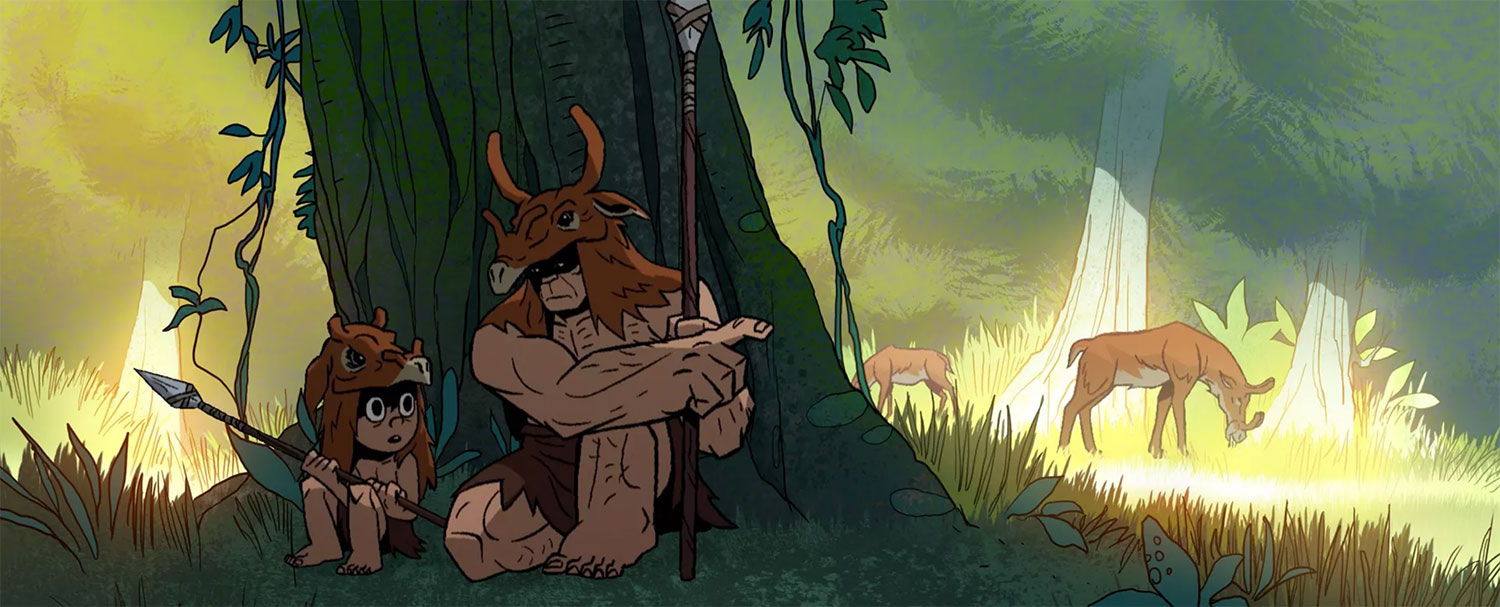
What is an example of a note you took onboard?
Primal didn’t have a lot of notes [laughs]. On Dexter, we got greenlit for six half-hour episodes, then another seven. Before we started the seven, we had a big conversation about Dee Dee’s involvement. [Mike] wanted to make sure she was being built up as a character and propelled forward. That was definitely a big part of my thinking too, but it was his thinking that pushed it, and it was a really good thought.
Oh yeah, on Primal, we talked about not trying to make it too serial-like, with big cliffhangers. I think, initially, I started to build it that way, and it was a good call not to make everything like, “Woah! Now you’ve got to tune in next week!” Nowadays, especially with streaming, a lot of shows are made that way.
As you were saying, the absence of dialogue in Primal builds on what you were trying out in your previous works, like Samurai Jack. It feels like a culmination. Is there another challenge you now want to set for yourself?
I want to push boundaries like this in features. We’re so limited in what we can do in features… There’s still nothing like a theatrical experience…it’s immersive. All the stuff I’ve learned from tv, I want to translate into features. Sometimes it’s hard to experiment with that kind of pressure and money. In features you have an opening weekend, and if you don’t connect, you’re dead.
At Sony Pictures Animation, we’re trying this right now. We’ve announced two movies [that I’m directing]. One is rated R, the comedy Fixed. The other is more of a PG-ish action adventure [called Black Knight] — there’s no comedy sidekick or talking animals. It’s kind of like Primal: very hardcore, no gore or anything, but more adult. We’ve talked about hand-drawn, and some bits may be cgi. It’s one step at a time. Can they make it through? We’ll see.

.png)
